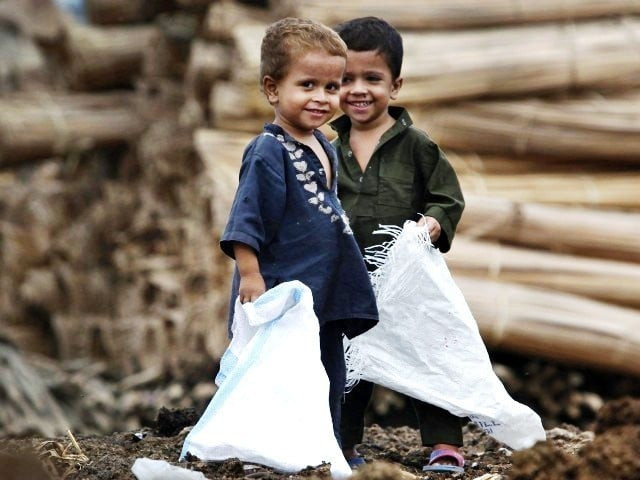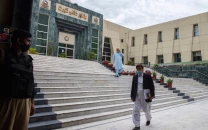At 8.6%, Pakistan is among countries with highest infant mortality: UNICEF report
Number of literate adult women in Pakistan is 59% that of literate adult males with an average literacy rate of 55%.

Approximately 409,000 children in Pakistan died below the age of five in 2012. PHOTO: REUTERS FILE
The year 2014 is the 25th anniversary of the Convention on the Rights of the Child, while 2015 will be the culminating year of the Millennium Development Goals (MDGs). On this occasion, UNICEF says it hopes the data in its latest report can "continue to support advocacy and action on behalf of the world's 2.2 billion children."
The report, which uses the latest available data in 2012 from multiple UN and World Bank sources, particularly focuses on disparities in the conditions of children belonging from different regions or classes.

A few of the global highlights are given below:
-About 90 million children who would have died if mortality rates had stuck at their 1990 level have, instead, lived past the age of 5
-Deaths from measles among children under 5 years of age fell from 482,000 in 2000 to 86,000 in 2012, thanks in large part to immunisation coverage, which increased from 16 per cent in 1980 to 84 per cent in 2012
-Primary school enrolment has increased, even in the least developed countries: Whereas in 1990 only 53 per cent of children in those countries gained school admission, by 2011 the rate had improved to 81 per cent
-Nearly 1.9 billion people have gained access to improved sanitation
since 1990
-Some 6.6 million children under 5 years of age died in 2012, mostly from preventable causes, their fundamental right to survive and develop unrealised
-Fifteen per cent of the world’s children engage in child labour that compromises their right to protection from economic exploitation and infringes on their right to learn and play
-Eleven per cent of girls are married before they turn 15, jeopardising their rights to health, education and protection

Statistics from Pakistan
Infant Mortality: According to the report, an estimated 86 babies died below the age of five per every 1000 live births in Pakistan during the year 2012. The figure comes from 409,000 babies dying below the age of five out of 4,604,000 newborns in 2012.
The 8.6% rate is an improvement since 1990, when the under-five mortality rate was measured at 13.8%.
For children under the age of one, the number of babies dying per a thousand births was 106 in 1990, and an improved 69 in 2012.
Also for 2012, the average life expectancy for every newborn child was 66, while one third of all children under the age of five in Pakistan were underweight.
41.2 per cent (73.8 million) of Pakistan's 179.1 million population is 18-years old or younger.
Marriage and birth:
The report revealed that seven per cent of Pakistanis were married by the age of 15, and 24% by 18.
A staggering 87, 000 people are living with HIV in 2012.
In urban areas, twice as many women were likely to have a skilled attendant at their birth than in rural areas.
10% of Pakistani girls currently aged between 20-24 gave birth before the age of 18.
27% of all married women currently use some contraceptive method.
Literacy:
Using the most recent statistics available for study and defining 'literacy' as the ability to 'both read and write with understanding a short simple/statement on his/her everyday life', UNICEF also measured Pakistan's total adult literacy rate at 55%.
Specifically for youth (aged between 15-24), literacy rates were 79% for males and 61% for females.
The number of literate adult women was 59% that of literate adult males.
Of all males belonging to the official secondary school age category, 40% were enrolled in secondary school. For females, the number was 29%.
Health:
The report gave a surprisingly high number for the percentage of people with access to 'improved drinking water sources' in 2011: 91%.
As for access to sanitation, 72% of the urban population had access to improved sanitation facilities. In rural areas, the number was just 34%, bringing the country average to 47%.
According to UNICEF data, the percentage of live births in Pakistan who were vaccinated for safety against various diseases always stayed below 90. The numbers were lowest for the percentage of babies receiving at least three doses of polio vaccination or the number of newborns protected against Tetanus — 75% in each of the cases.
Economy:
The average annual rate of inflation across the years 1990-2012 was 10%.
In 2012, 21% of Pakistanis were living in abject poverty, below the international poverty line of $1.25 per day.
67% of the country's population was subscribed to mobile telephone services in 2012, and an estimated 10% were internet users.



















COMMENTS
Comments are moderated and generally will be posted if they are on-topic and not abusive.
For more information, please see our Comments FAQ